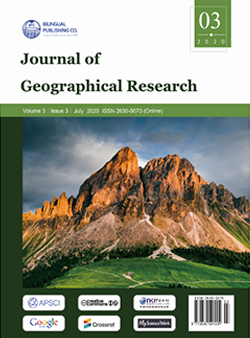-
1445
-
372
-
303
-
233
-
195
Biogas Technology Adoption as an Alternative Source of Energy in Domboshava Communal Area of Zimbabwe: Benefits and Challenges
DOI:
https://doi.org/10.30564/jgr.v3i3.2151Abstract
The research examines challenges and opportunities of biogas technology adoption to achieve sustainable household energy in Ward 4 of Domboshava communal area, Zimbabwe. The research adopted both qualitative and quantitative research techniques. A total of 65 questionnaires were randomly distributed to households using biogas. Purposive sampling technique was employed to select key informants from the Environmental Management Agency, Netherlands Development Organisation, Zimbabwe Energy Regulatory Authority, Environment Africa and the Ward Councillor.The study revealed that the level of education attained do not influence biogas adoption (p > 0.05) whereas funds availability,awareness,promoters and gender of the household head were seen to have a major effect (p < 0.05).The benefits of biogas technology noted by households were that it cooks fast,provides clean energy and at the same time reducing the frequency of fire wood collection in the forest.Challenges such as lack of adequate knowledge about the technology and lack of required financial and material resources compromised the adoption of biogas technology by the households in Ward 4.The study recommends that relevant government agencies should provide accessible technical services and set up demonstration centres in every ward with a view of encouraging rural households to adopt biogas technology.
Keywords:
Biogas; Sustainability; Renewable energy; Rural communitiesReferences
[1] Abukhzam M., Lee, A. Workforce Attitude on Technology Adoption and Diffusion. The Built and Human Environment Review,2010, 3(1): 60-71.
[2] Adeola, I. E, Hermish, L. Emphraim, O. Rethinking Biomass Energy in Africa, Berlin: Association of German Development NGOs (VENRO), 2009.
[3] Amigun, B., Maska V. R, Bruce. H Commercialisation of biofuel industry in Africa: A review.Renewable and Sustainable Energy Reviews, 2008, 12: 690-711.
[4] Bonnke B.M. An assessment of factors influencing the choice and adoption of biogas technology among Peri Urban residents of Kisii County, University of Nairobi: Unpublished Dissertation, 2014.
[5] Bruce, N. The health effects of indoor pollution exposure in developing contries, Geneva: World Health Organization, 2000.
[6] Collins, Pindozzi, S., Faugno, S, Boccia, L. Development of bioenergy technologies in Uganda: A review of progress. Renewable and Sustainable Energy Reviews, 2013, 18(C): 55-63.
[7] Creswell, J. W. Research Design: Qualitative, Quantitative and Mixed Methods Approaches. 3rd ed.Los Angeles: Sage Publications Inc, 2009.
[8] Hivos, I. Feasibility on a national domestic biogas programme in Zimbabwe. Harare: SNV Zimbabwe,2012.
[9] Ingwani, E. Land Transactions and Rezoning Strategies in the Peri Urban Communal Area of Domboshava, Zimbabwe: Challenges and Pitfalls. Reviewed Paper, 2015: 379-395
[10] Mbulayi, R. B. The effects of deforestation on rural women. Case of Chiwundura. Unpublished Dissertation (BA), Midlands State University, 2013.
[11] Mishra, V. Indoor air pollution from biomass combustion and acute respiratory illness in preschools age in Zimbabwe. International Journal of Epidemiology, 2003, 32: 847-853.
[12] Miyuki, I., Neufeldt, H., Dobie P, Mary, N. The potential of agroforestry in the provision of sustainable wood fuel in sub-Saharan Africa. Current Opinion in Environmental Sustainability, 2014, 6:138-147.
[13] Mshandete AM, Parawira W. Biogas technology research in selected sub-Saharan African countries. A review. African Journal of Biotechnology, 2009, 8(2):116-125.
[14] Muriuki, S. W. Analysis of biogas technology for household energy, sustainable livelihoods and climate change mitigation in Kiambu County, Kenya,Nairobi: Kenyatta University, 2014.
[15] Mwakaje, A. Dairy farming and biogas use in Rungwe District, South-west Tanzania: a study of opportunities and constraints. Renewable and Sustainable Energy Reviews, 2008, 12: 2240-2252.
[16] Ngumah, C. C., Ogbulie, J. N., Orji, J. C, Amadi, E. S.Biogas Potential of Organic Waste in Nigeria. Journal of Urban and Environmental Engineering, 2013,1(7): 110-116.
[17] `Parawira, J.K, Mshandete, L.A, Adamas, A., Sighr,B. Anaerobic Biogas Generation for Rural Area Energy Provision in Africa. In: D. S. Kumar, ed. Biogas.Croatia: In Tech, 2012: 35-61.
[18] Scarlat, N. Evaluation of energy potential of Municipal Solid Waste from African Cities.Renewable and Sustainable Energy Reviews, 2015: 1269-1296.
[19] Smith, J. The Potential of Small-Scale Biogas Digesters to Alleviate Poverty and Improve Long Term Sustainability of Ecosystem Services in Sub-Saharan Africa, University of Aberdeen, , 2012.
[20] Thomas, P. Y. Towards developing a web-based blended learning environment at the University of Botswana. Pretoria, University of South Africa, 2010.
[21] UNDP. The energy access situation in developing countries: A review focusing on the least developed countries and Sub Saharan Africa, New York: UNDP,2013.
[22] Wamuyu, M. S. Analysis of biogas technology for household energy, sustainable livelihoods and climate change mitigation Kiambu County, Kenya, Nairobi.Kenyatta University, 2014.
[23] Waqah, A., Irfan, M., Iqbal S., Waqar I. The Perception about the Biogas Technology Adoption: A Case Study of District Faisalabad (Punjab, Pakistan). Middle-East Journal of Scientific Research, 2013,17(2):256-259.
[24] Wawa, A. I. The challenges of promoting and adopting biogas technology as alternative energy source in semi-arid areas of Tanzania: the case of Kongwa and Bahi districts of Dodoma region, Unpublished thesis (PHD), Open University of Tanzania, 2012.
[25] Zimbabwe Energy Regulatory Authority, 2013.Available at:http://www.zera.co.zw [Accessed 21 September 2019].Zimbabwe Poverty Atlas. 2015. Available at:http://www.zimstat.co.zw/ [Accessed 05 10 2019].
[26] Zvigadza, S., Mharadze, G, Ngena, S. Communities and climate change: Building local capacity for adaptation in Goromonzi District. Munyawiri Ward,Zimbabwe, Harare, 2010.
Downloads
How to Cite
Issue
Article Type
License
Copyright © 2020 Thomas Marambanyika, Shingirayi Sakarombe, Tatenda Musasa, Rameck Defe

This is an open access article under the Creative Commons Attribution-NonCommercial 4.0 International (CC BY-NC 4.0) License.




 Thomas Marambanyika
Thomas Marambanyika





